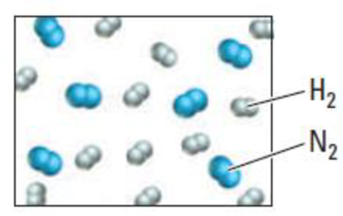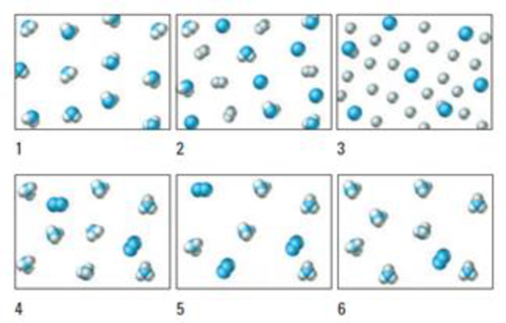
Chemistry: The Molecular Science
5th Edition
ISBN: 9781285199047
Author: John W. Moore, Conrad L. Stanitski
Publisher: Cengage Learning
expand_more
expand_more
format_list_bulleted
Concept explainers
Textbook Question
Chapter 3, Problem 121QRT
Ammonia can be formed by a direct reaction of nitrogen and hydrogen.
N2(g) + 3 H2(g) → 2 NH3(g)
A tiny portion of the starting mixture is represented by the diagram, where the blue circles represent N and the white circles represent H.

Which of these represents the product mixture?

For the reaction of the given sample, which of these statements is true?
- (a) N2 is the limiting reactant.
- (b) H2 is the limiting reactant.
- (c) NH, is the limiting reactant.
- (d) No reactant is limiting: they are present in the correct stoichiometric ratio.
Expert Solution & Answer
Trending nowThis is a popular solution!

Students have asked these similar questions
Reason whether it is possible to determine changes in the Galvani potential difference at the metal-solution interface.
Obtain the standard potential at 25°C of the Cu* I Cu | Pt electrode
from the standard potentials E°
Cu²+/Cu
= 0.341 V and E
Cu²+ /Cu+
= 0.153 V.
In electrochemistry, briefly describe the Galvani potential, the Volta potential, and the surface potential. Differentiate between them.
Chapter 3 Solutions
Chemistry: The Molecular Science
Ch. 3.1 - When washing soda, Na2CO3, reacts with sulfuric...Ch. 3.2 - When sprayed into the flame of a torch, powdered...Ch. 3.2 - Prob. 3.1PSPCh. 3.2 - Prob. 3.2PSPCh. 3.3 - Prob. 3.3PSPCh. 3.3 - Prob. 3.4PSPCh. 3.3 - Prob. 3.5PSPCh. 3.3 - Prob. 3.6PSPCh. 3.3 - Prob. 3.3CECh. 3.4 - Phosphoric acid, H3PO4, has three protons that can...
Ch. 3.4 - Prob. 3.5CECh. 3.4 - Look back through the discussion of electrolytes...Ch. 3.4 - Prob. 3.8PSPCh. 3.4 - Prob. 3.9PSPCh. 3.4 - Write a balanced equation for the reaction of...Ch. 3.4 - Prob. 3.6ECh. 3.4 - Prob. 3.7ECh. 3.4 - Prob. 3.8ECh. 3.4 - Prob. 3.9CECh. 3.4 - Prob. 3.10CECh. 3.5 - Prob. 3.11CECh. 3.5 - Prob. 3.12CECh. 3.5 - Prob. 3.13ECh. 3.5 - Prob. 3.11PSPCh. 3.5 - Prob. 3.12PSPCh. 3.5 - Prob. 3.14CECh. 3.6 - Prob. 3.15CECh. 3.6 - Prob. 3.16ECh. 3.6 - Prob. 3.13PSPCh. 3.6 - Prob. 3.17ECh. 3.6 - Prob. 3.14PSPCh. 3.7 - Prob. 3.15PSPCh. 3.7 - Using the same reaction, calculate the mass of...Ch. 3.7 - At high temperatures, silicon dioxide reacts with...Ch. 3.7 - Urea is used as a fertilizer because it can react...Ch. 3.8 - Assume the methanol synthesis has an 85.0% yield...Ch. 3.8 - Prob. 3.19PSPCh. 3.8 - Prob. 3.19ECh. 3.8 - Prob. 3.20ECh. 3.9 - Phenol is a compound of carbon, hydrogen, and...Ch. 3.9 - Calcium carbonate forms carbon dioxide and calcium...Ch. 3.10 - Prob. 3.20PSPCh. 3.10 - Prob. 3.23ECh. 3.10 - Prob. 3.24ECh. 3.10 - Prob. 3.25CECh. 3.10 - Describe how you would prepare each solution.
1.00...Ch. 3.10 - Prob. 3.26ECh. 3.10 - Prob. 3.22PSPCh. 3.10 - Prob. 3.27CECh. 3.11 - Prob. 3.23PSPCh. 3.11 - Prob. 3.24PSPCh. 3.11 - Sodium chloride is used in intravenous solutions...Ch. 3.12 - Show that the reaction of KMnO4 with H2O2 is a...Ch. 3.12 - Prob. 3.25PSPCh. 3 - Aqueous solutions of ammonium sulfide and...Ch. 3 - In a blast furnace at high temperature, iron(III)...Ch. 3 - What information does a balanced chemical equation...Ch. 3 - Prob. 2QRTCh. 3 - Prob. 3QRTCh. 3 - Prob. 4QRTCh. 3 - Prob. 5QRTCh. 3 - Prob. 6QRTCh. 3 - When asked, “What is the limiting reactant?” you...Ch. 3 - Prob. 8QRTCh. 3 - Prob. 9QRTCh. 3 - For this reaction, fill in the table with the...Ch. 3 - Prob. 11QRTCh. 3 - Prob. 12QRTCh. 3 - This diagram shows A (blue spheres) reacting with...Ch. 3 - Prob. 14QRTCh. 3 - Prob. 15QRTCh. 3 - Prob. 16QRTCh. 3 - Prob. 17QRTCh. 3 - Prob. 18QRTCh. 3 - Prob. 19QRTCh. 3 - Balance these equations. (a) UO2(s) + HF() UF4(s)...Ch. 3 - Prob. 21QRTCh. 3 - Prob. 22QRTCh. 3 - Prob. 23QRTCh. 3 - Balance these combustion reactions. (a) C6H12O6 +...Ch. 3 - Prob. 25QRTCh. 3 - Prob. 26QRTCh. 3 - Prob. 27QRTCh. 3 - Which substance conducts electricity when...Ch. 3 - Prob. 29QRTCh. 3 - Predict whether each compound is soluble in water....Ch. 3 - Prob. 31QRTCh. 3 - Which drawing is the best nanoscale representation...Ch. 3 - If aqueous solutions of potassium carbonate and...Ch. 3 - If aqueous solutions of potassium sulfide and...Ch. 3 - Prob. 35QRTCh. 3 - Prob. 36QRTCh. 3 - Prob. 37QRTCh. 3 - Prob. 38QRTCh. 3 - Prob. 39QRTCh. 3 - Prob. 40QRTCh. 3 - Prob. 41QRTCh. 3 - Prob. 42QRTCh. 3 - Prob. 43QRTCh. 3 - Prob. 44QRTCh. 3 - Prob. 45QRTCh. 3 - Prob. 46QRTCh. 3 - Prob. 47QRTCh. 3 - Prob. 48QRTCh. 3 - Prob. 49QRTCh. 3 - Prob. 50QRTCh. 3 - Prob. 51QRTCh. 3 - Prob. 52QRTCh. 3 - Prob. 53QRTCh. 3 - Prob. 54QRTCh. 3 - Prob. 55QRTCh. 3 - Prob. 56QRTCh. 3 - Prob. 57QRTCh. 3 - Prob. 58QRTCh. 3 - Nitrogen monoxide is oxidized in air to give brown...Ch. 3 - Prob. 60QRTCh. 3 - The final step in the manufacture of platinum...Ch. 3 - Disulfur dichloride, S2Cl2, is used to vulcanize...Ch. 3 - Prob. 63QRTCh. 3 - Prob. 64QRTCh. 3 - Prob. 65QRTCh. 3 - Prob. 66QRTCh. 3 - Prob. 67QRTCh. 3 - Cisplatin, Pt(NH3)2Cl2, a drug used in the...Ch. 3 - Aluminum chloride, Al2Cl6, is an inexpensive...Ch. 3 - Prob. 70QRTCh. 3 - Prob. 71QRTCh. 3 - Prob. 72QRTCh. 3 - Prob. 73QRTCh. 3 - Quicklime, CaO, is formed when calcium hydroxide...Ch. 3 - Prob. 75QRTCh. 3 - Disulfur dichloride, which has a revolting smell,...Ch. 3 - Prob. 77QRTCh. 3 - Prob. 78QRTCh. 3 - Quinone, which is used in the dye industry and in...Ch. 3 - l-Dopa is a drug used for the treatment of...Ch. 3 - Write the balanced chemical equation for the...Ch. 3 - Prob. 82QRTCh. 3 - Prob. 83QRTCh. 3 - Prob. 84QRTCh. 3 - Prob. 85QRTCh. 3 - Prob. 86QRTCh. 3 - You need 300. mL of 0.500-M K2Cr2O7. Which method...Ch. 3 - You need to make a 0.300-M solution of NiSO4(aq)....Ch. 3 - You wish to make a 0.200-M solution of CuSO4(aq)....Ch. 3 - Prob. 90QRTCh. 3 - Prob. 91QRTCh. 3 - You mix 25.0 mL of 0.234-M FeCl3 solution with...Ch. 3 - A soft drink contains an unknown mass of citric...Ch. 3 - Prob. 94QRTCh. 3 - Prob. 95QRTCh. 3 - Potassium hydrogen phthalate, KHC8H4O4, is used to...Ch. 3 - Prob. 97QRTCh. 3 - Prob. 98QRTCh. 3 - Prob. 99QRTCh. 3 - Prob. 100QRTCh. 3 - Boron forms an extensive series of compounds with...Ch. 3 - Prob. 102QRTCh. 3 - Prob. 103QRTCh. 3 - Prob. 104QRTCh. 3 - Prob. 105QRTCh. 3 - Azurite is a copper-containing mineral that often...Ch. 3 - Prob. 107QRTCh. 3 - Prob. 108QRTCh. 3 - Vitamin C is ascorbic acid, HC6H7O6, which can be...Ch. 3 - Prob. 110QRTCh. 3 - Prob. 111QRTCh. 3 - Prob. 112QRTCh. 3 - Prob. 113QRTCh. 3 - Prob. 114QRTCh. 3 - Prob. 115QRTCh. 3 - Prob. 116QRTCh. 3 - Prob. 117QRTCh. 3 - Prob. 118QRTCh. 3 - Prob. 119QRTCh. 3 - Prob. 120QRTCh. 3 - Ammonia can be formed by a direct reaction of...Ch. 3 - Carbon monoxide burns readily in oxygen to form...Ch. 3 - Prob. 123QRTCh. 3 - Write a balanced chemical equation that represents...Ch. 3 - A student set up an experiment for six different...Ch. 3 - A weighed sample of a metal is added to liquid...Ch. 3 - Prob. 127QRTCh. 3 - Prob. 128QRTCh. 3 - Each box represents a tiny volume in an aqueous...Ch. 3 - Consider the chemical reaction 2 S + 3 O2 → 2 SO3....Ch. 3 - Prob. 131QRTCh. 3 - Prob. 132QRTCh. 3 - Prob. 133QRTCh. 3 - Prob. 134QRTCh. 3 - Prob. 135QRTCh. 3 - Prob. 136QRTCh. 3 - Prob. 137QRTCh. 3 - Prob. 138QRTCh. 3 - Prob. 139QRTCh. 3 - Prob. 140QRTCh. 3 - Prob. 141QRTCh. 3 - Prob. 142QRTCh. 3 - In a reaction, 1.2 g element A reacts with exactly...Ch. 3 - Prob. 144QRTCh. 3 - When solutions of silver nitrate and sodium...Ch. 3 - Nickel metal reacts with aqueous silver nitrate in...Ch. 3 - Prob. 147QRTCh. 3 - Prob. 148QRTCh. 3 - Prob. 149QRTCh. 3 - Prob. 150QRTCh. 3 - A mountain lake that is 4.0 km × 6.0 km with an...Ch. 3 - Prob. 152QRTCh. 3 - Prob. 153QRTCh. 3 - Prob. 154QRTCh. 3 - Prob. 155QRTCh. 3 - Ethanol, C2H5OH, is a gasoline additive that can...Ch. 3 - Prob. 157QRTCh. 3 - Prob. 3.ACPCh. 3 - Prob. 3.BCPCh. 3 - Prob. 3.DCPCh. 3 - Prob. 3.ECPCh. 3 - Prob. 3.FCPCh. 3 - Prob. 3.GCP
Knowledge Booster
Learn more about
Need a deep-dive on the concept behind this application? Look no further. Learn more about this topic, chemistry and related others by exploring similar questions and additional content below.Similar questions
- What substances can neutralize, complex or adsorb and absorb both HF and CF carbonyl fluoride and hydrogen fluoride and intermediate formation of thermal decomposition of fluorinated inorganic compounds either due to hydrolysis and hygroscopic reactions. What is the known chemistry of these reactions and mechanisms.arrow_forwardBriefly differentiate between chemical potential and electrochemical potential.arrow_forwardAccording to open access forums ionic antimony Sb (111) can be reduced to elemental Sb (0) in solution and in macromolecules like condensation polymers polyethylene terephthalate (PET) causing greying of the polymer matrix. It has been connected to thermal degradation of the polymer during processing to the formation of thermally unstable EG ethyleen glycol that forms at various temperatures formic acid, formaldehyde, acetaldehyde and much more depending on temperature. I need to know what organics are more powerful reducing agents and at what concentration (relative) to each organic will initiate this reduction. Furthermore, is the pH dependant ? Are other trace elements in the plastic also a cause of concern e.g. aluminum from aluminum chloride (lewis acid). Therefore, the ultimate solution should include a means to inhibit reduction of ionic antimony and will the same solution comply with cobalt impurities from ionic cobalt? Some PET have combinations of catalyst and their residues…arrow_forward
- From a pH standpoint is the reduction of ionic Antimony Sb (111) to elemental Sb (0) occur more readily by acidic species acting as reducing agents or basic substances? I want to inhibit this reduction of ionic to elemental. Suggestions and directions!arrow_forwardObtain the standard potential at 25°C of the Cu* I Cu | Pt electrode from the standard potentials E° Cu²+/Cu = 0.341 V and E Cu²+ /Cu+ = 0.153 V.arrow_forwardState two variables on which the transport number in electrochemistry depends.arrow_forward
arrow_back_ios
SEE MORE QUESTIONS
arrow_forward_ios
Recommended textbooks for you
 Chemistry for Engineering StudentsChemistryISBN:9781337398909Author:Lawrence S. Brown, Tom HolmePublisher:Cengage Learning
Chemistry for Engineering StudentsChemistryISBN:9781337398909Author:Lawrence S. Brown, Tom HolmePublisher:Cengage Learning ChemistryChemistryISBN:9781305957404Author:Steven S. Zumdahl, Susan A. Zumdahl, Donald J. DeCostePublisher:Cengage Learning
ChemistryChemistryISBN:9781305957404Author:Steven S. Zumdahl, Susan A. Zumdahl, Donald J. DeCostePublisher:Cengage Learning Chemistry: An Atoms First ApproachChemistryISBN:9781305079243Author:Steven S. Zumdahl, Susan A. ZumdahlPublisher:Cengage Learning
Chemistry: An Atoms First ApproachChemistryISBN:9781305079243Author:Steven S. Zumdahl, Susan A. ZumdahlPublisher:Cengage Learning
 Chemistry: Principles and PracticeChemistryISBN:9780534420123Author:Daniel L. Reger, Scott R. Goode, David W. Ball, Edward MercerPublisher:Cengage Learning
Chemistry: Principles and PracticeChemistryISBN:9780534420123Author:Daniel L. Reger, Scott R. Goode, David W. Ball, Edward MercerPublisher:Cengage Learning Chemistry: The Molecular ScienceChemistryISBN:9781285199047Author:John W. Moore, Conrad L. StanitskiPublisher:Cengage Learning
Chemistry: The Molecular ScienceChemistryISBN:9781285199047Author:John W. Moore, Conrad L. StanitskiPublisher:Cengage Learning

Chemistry for Engineering Students
Chemistry
ISBN:9781337398909
Author:Lawrence S. Brown, Tom Holme
Publisher:Cengage Learning

Chemistry
Chemistry
ISBN:9781305957404
Author:Steven S. Zumdahl, Susan A. Zumdahl, Donald J. DeCoste
Publisher:Cengage Learning

Chemistry: An Atoms First Approach
Chemistry
ISBN:9781305079243
Author:Steven S. Zumdahl, Susan A. Zumdahl
Publisher:Cengage Learning


Chemistry: Principles and Practice
Chemistry
ISBN:9780534420123
Author:Daniel L. Reger, Scott R. Goode, David W. Ball, Edward Mercer
Publisher:Cengage Learning

Chemistry: The Molecular Science
Chemistry
ISBN:9781285199047
Author:John W. Moore, Conrad L. Stanitski
Publisher:Cengage Learning
Bonding (Ionic, Covalent & Metallic) - GCSE Chemistry; Author: Science Shorts;https://www.youtube.com/watch?v=p9MA6Od-zBA;License: Standard YouTube License, CC-BY
Stoichiometry - Chemistry for Massive Creatures: Crash Course Chemistry #6; Author: Crash Course;https://www.youtube.com/watch?v=UL1jmJaUkaQ;License: Standard YouTube License, CC-BY